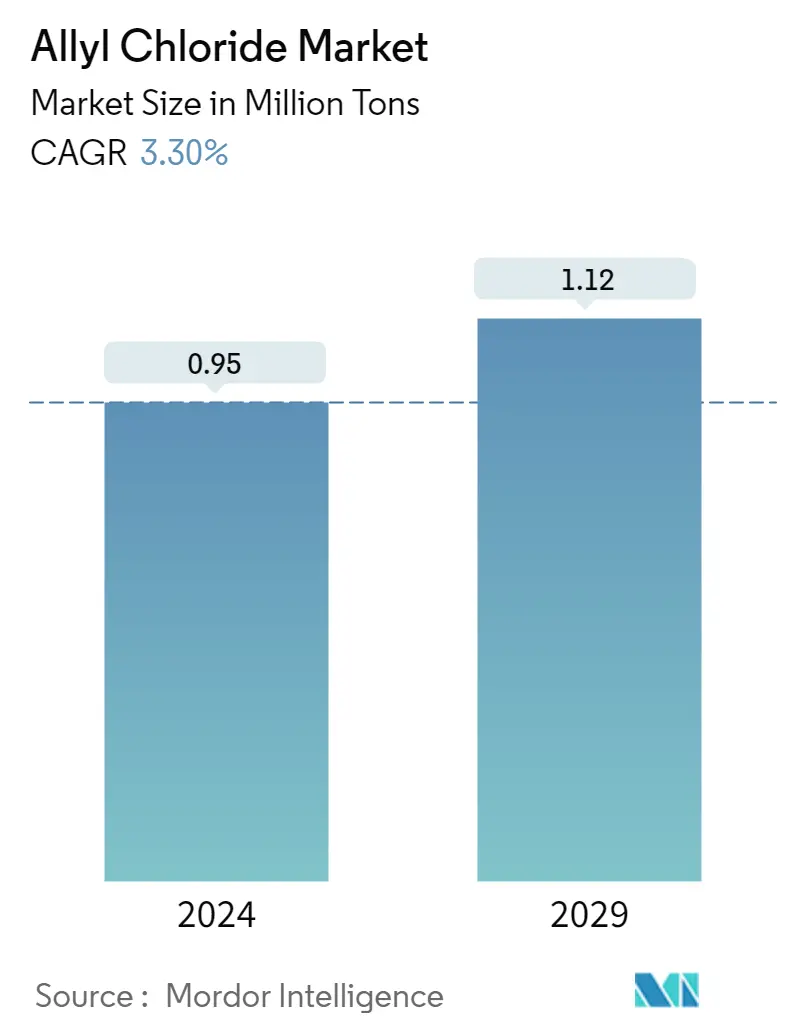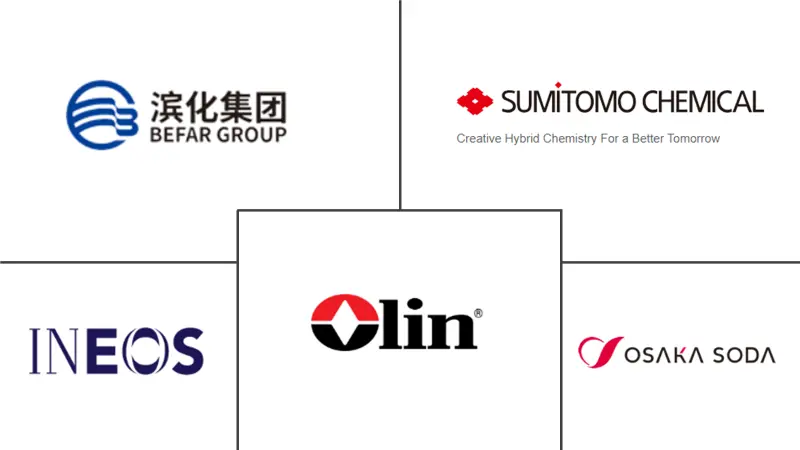Market Size of Allyl Chloride Industry

| Study Period | 2019 - 2029 |
| Base Year For Estimation | 2023 |
| CAGR (2024 - 2029) | 3.30 % |
| Fastest Growing Market | Europe |
| Largest Market | Asia Pacific |
| Market Concentration | Low |
Major Players
*Disclaimer: Major Players sorted in no particular order |
Allyl Chloride Market Analysis
The Allyl Chloride Market size is estimated at 0.95 Million tons in 2024, and is expected to reach 1.12 Million tons by 2029, growing at a CAGR of 3.30% during the forecast period (2024-2029).
- Due to the COVID-19 outbreak, nationwide lockdowns around the world, disruption in manufacturing activities and supply chains, and production halts negatively impacted the market in 2020. However, the conditions started recovering in 2021, restoring the market's growth trajectory.
- Over the medium term, the increasing use of allyl chloride derivatives in several applications will be the primary factor for driving the market demand in the studied period.
- On the flip side, factors such as stringent government regulations and increasing knowledge of Bio-based epichlorohydrin are expected to hinder market growth. The emergence of various allyl chloride polymers and copolymers as plasticizers and emulsifiers is expected to act as an opportunity for the market studied.
- Asia-Pacific region represents the largest market owing to the consumption from countries such as China, South Korea, India, and Japan.
Allyl Chloride Industry Segmentation
Allyl chloride is an organochlorine compound. It is mainly converted to epichlorohydrin, used in the production of plastics.
The allyl chloride market is segmented by application and geography. By application, the market is segmented into allyl amines, allyl sulfonates, epichlorohydrin, glycidyl ether, water treatment chemicals, and others (adhesives, perfumes, and pharmaceuticals). The report also covers the market size and forecasts for the allyl chloride market in different countries across major regions, including North America, Europe, Asia-Pacific, Latin America, the Middle East, and Africa.
For each segment, the market sizing and forecasts have been done in volume (kilotons).
| Application | |
| Allyl Amines | |
| Allyl Sulfonates | |
| Epichlorohydrin | |
| Glycidyl Ether | |
| Water Treatment Chemicals | |
| Other Applications (Adhesives, Perfumes, Pharmaceuticals) |
| Geography | |||||||
| |||||||
| |||||||
| |||||||
| |||||||
|
Allyl Chloride Market Size Summary
The allyl chloride market is poised for steady growth over the forecast period, driven primarily by its application in the production of epichlorohydrin, a key component in various industries such as coatings, adhesives, and plastics. The market experienced disruptions due to the COVID-19 pandemic, but recovery began in 2021, restoring its growth trajectory. The Asia-Pacific region, particularly countries like China, South Korea, India, and Japan, represents the largest market due to high consumption in industries such as epichlorohydrin, glycidyl ether, and allyl amines. The region's demand is further bolstered by China's significant production capacity and its status as a leading producer of epoxy resin and pharmaceuticals.
Despite the promising growth prospects, the market faces challenges from stringent government regulations and the increasing adoption of bio-based alternatives. However, opportunities exist in the development of allyl chloride polymers and copolymers as plasticizers and emulsifiers. The market is characterized by a fragmented landscape with no single company holding a dominant share, although key players include INEOS, Olin Corporation, and Solvay. The ongoing expansion projects, such as Sinopec's upgrade in Northern China, aim to enhance production capacity and meet the rising demand for epichlorohydrin, thereby supporting the allyl chloride market's growth.
Allyl Chloride Market Size - Table of Contents
-
1. MARKET DYNAMICS
-
1.1 Drivers
-
1.1.1 Increasing Use of Allyl Chloride Derivatives in Several Applications
-
-
1.2 Restraints
-
1.2.1 Increasing Knowledge of Bio-based Epichlorohydrin
-
1.2.2 Stringent Environmental Regulations
-
-
1.3 Value Chain Analysis
-
1.4 Porter's Five Forces Analysis
-
1.4.1 Bargaining Power of Suppliers
-
1.4.2 Bargaining Power of Consumers
-
1.4.3 Threat of New Entrants
-
1.4.4 Threat of Substitute Products and Services
-
1.4.5 Degree of Competition
-
-
-
2. MARKET SEGMENTATION (Market Size in Volume)
-
2.1 Application
-
2.1.1 Allyl Amines
-
2.1.2 Allyl Sulfonates
-
2.1.3 Epichlorohydrin
-
2.1.4 Glycidyl Ether
-
2.1.5 Water Treatment Chemicals
-
2.1.6 Other Applications (Adhesives, Perfumes, Pharmaceuticals)
-
-
2.2 Geography
-
2.2.1 Asia-Pacific
-
2.2.1.1 China
-
2.2.1.2 India
-
2.2.1.3 Japan
-
2.2.1.4 South Korea
-
2.2.1.5 Rest of Asia-Pacific
-
-
2.2.2 North America
-
2.2.2.1 United States
-
2.2.2.2 Canada
-
2.2.2.3 Mexico
-
-
2.2.3 Europe
-
2.2.3.1 Germany
-
2.2.3.2 United Kingdom
-
2.2.3.3 France
-
2.2.3.4 Italy
-
2.2.3.5 Rest of Europe
-
-
2.2.4 South America
-
2.2.4.1 Brazil
-
2.2.4.2 Argentina
-
2.2.4.3 Rest of South America
-
-
2.2.5 Middle-East and Africa
-
2.2.5.1 Saudi Arabia
-
2.2.5.2 South Africa
-
2.2.5.3 Rest of Middle-East and Africa
-
-
-
Allyl Chloride Market Size FAQs
How big is the Allyl Chloride Market?
The Allyl Chloride Market size is expected to reach 0.95 million tons in 2024 and grow at a CAGR of 3.30% to reach 1.12 million tons by 2029.
What is the current Allyl Chloride Market size?
In 2024, the Allyl Chloride Market size is expected to reach 0.95 million tons.

